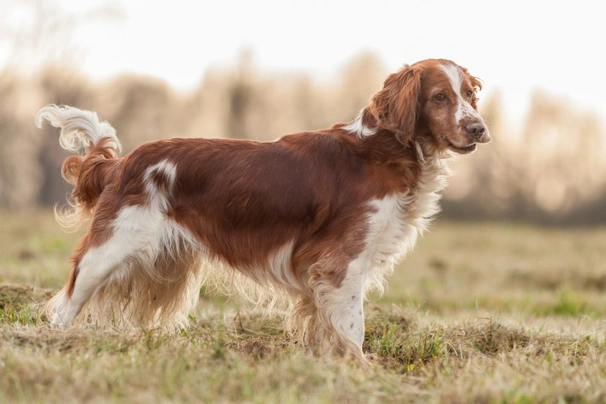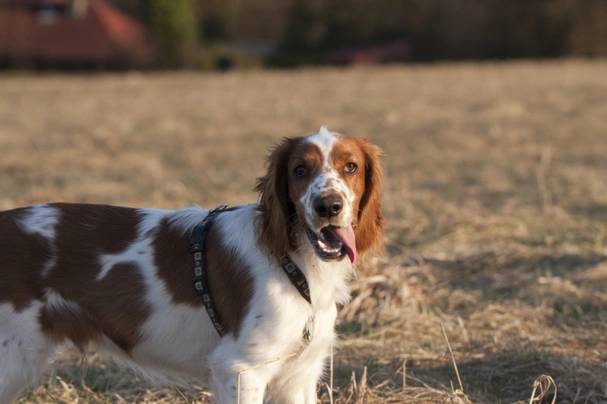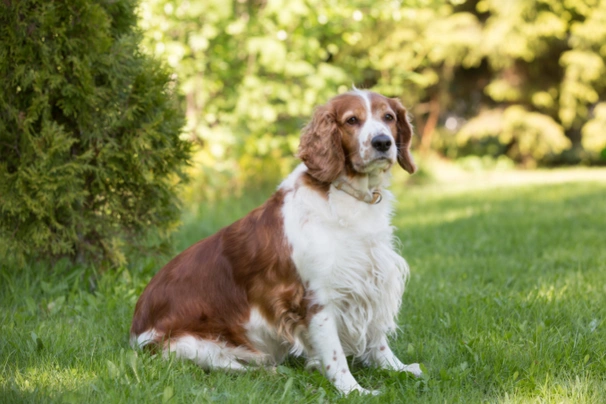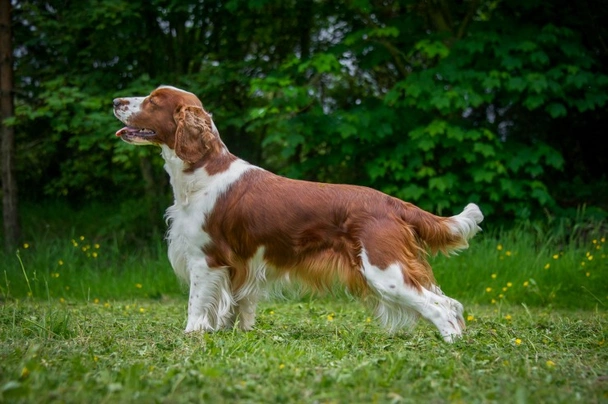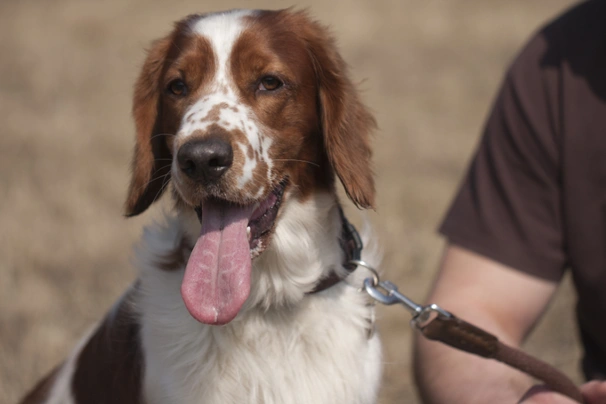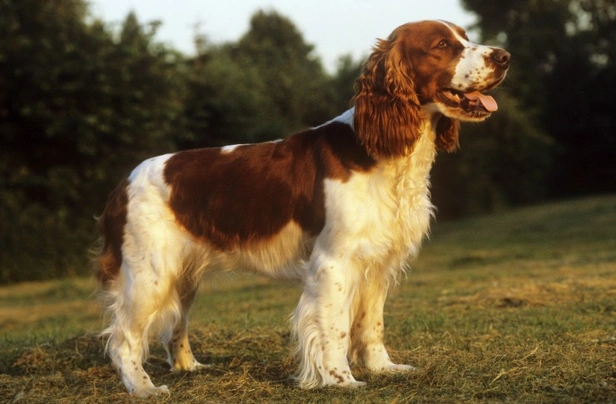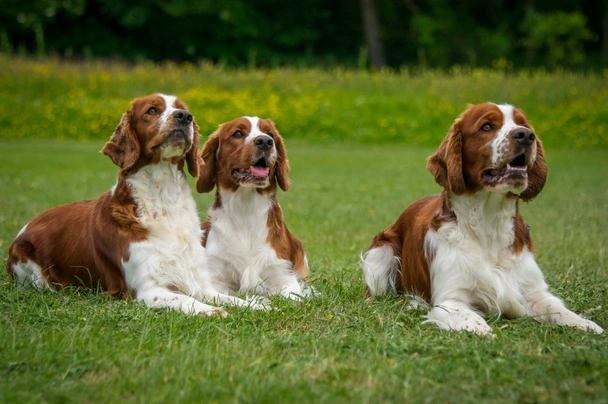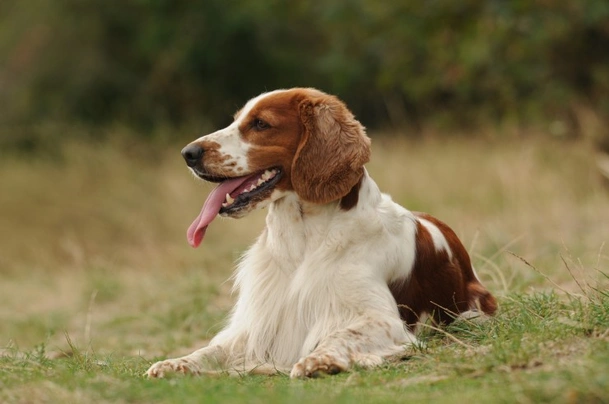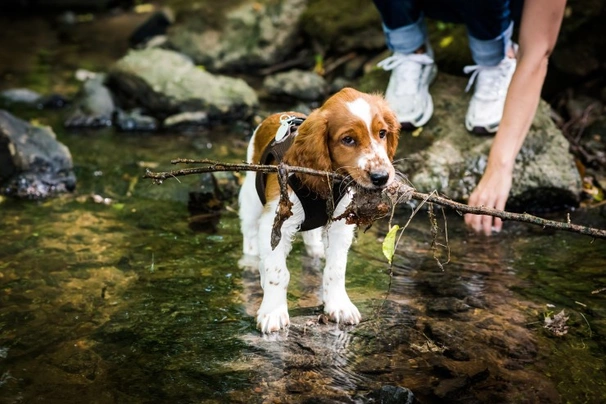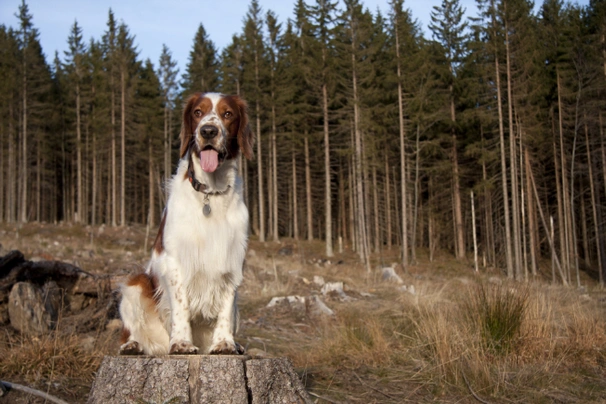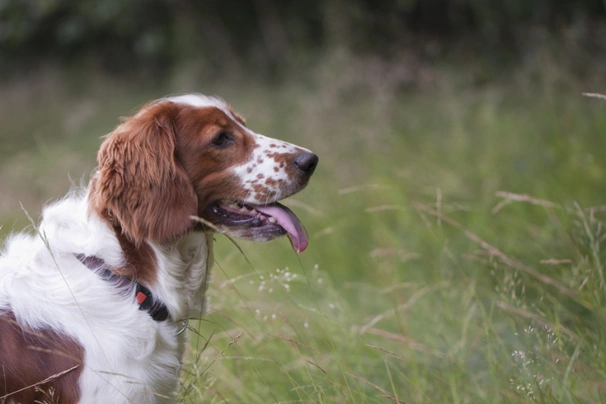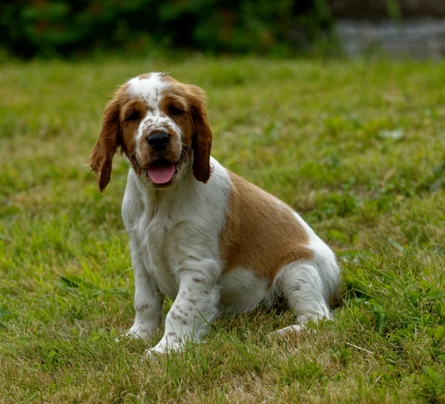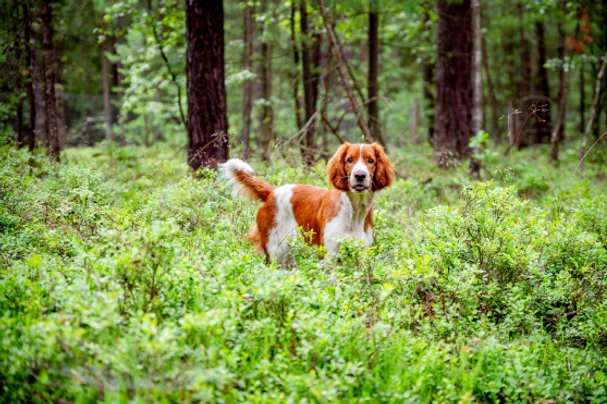Welsh Springer Spaniel
Pros
Cons
Introduction of the Welsh Springer Spaniel
The Welsh Springer Spaniel is an active lively and affectionate breed that was originally bred to be a gundog a job they are known to excel at. However over the years these attractive spaniels have found their way into the hearts and homes of many people thanks to their reliable temperaments charming looks and the fact they are especially good around children making them an ideal family pet
Welshies are better suited to people who lead active outdoor lives and who like to have an energetic intelligent canine companion at their side and a dog that enjoys taking part in all sorts of canine sports and activities with many Welsh Springer Spaniels still being used in a working environment where they have always been highly prized.
History of the Welsh Springer Spaniel
The Welsh Springer Spaniel is an ancient breed and one that has been depicted in works of art that date back to the 16th century. They were originally known as "Welsh Spaniels" and were bred to hunt game. They were commonly seen in Wales as well as in the west of England where they were also used to drive cattle and to herd flocks of sheep. These red and white spaniel’s ancestries can be traced back to the 18th Century but spaniels with the same colouring can be traced even further back to the 16th Century.
With this said the actual origins of the breed remain unknown but it is thought that the breed came about by crossing hounds as well as gundogs that were around both in Europe and Britain at the time. Many Welsh gentry kept spaniels during the 18th Century. However centuries later these hardworking loyal dogs became popular in other regions of the country and soon became highly prized gundogs all over the country. There are some people who believe Welsh Springer Spaniels were crossed with Corgis at some point in time but this is yet to be confirmed as true.
Welsh Springer Spaniels proved to be extremely versatile dogs that boasted a strong hunting instinct when asked to "spring or start" game. By the 19th and 20th centuries they became popular in other countries of the world which included America Australia and India. They were originally called Welsh Cockers but when the breed was recognised by The Kennel Club in 1902 their name was changed to Welsh Springer Spaniel.
Today these charming dogs are gaining popularity with people who are looking to share their homes with an energetic loyal and intelligent companion and one that enjoys being in the great outdoors with their owners whenever they can.
Interesting facts about the breed
- Is the Welsh Springer Spaniel a vulnerable breed? No although less well known than their Springer cousins they are fasts becoming a popular breed in a domestic environment and the show ring
- They were originally bred to work with falcons retrieving game birds they bought down
- In Wales Welsh Springers were always known as a breed since the 18th Century
- Linkhill is an Historic Kennel where many champion Welsh Springer Spaniels were bred
- Welshies have an "incredible" nose and can sniff out the tiniest morsel of food
- Traditionally a Welsh Springer Spaniel's tail was always docked but since the law banning the procedure came into effect in 2007 tail docking is now illegal with the exception being for some working breeds and if a dog suffers from some sort of health issue that requires their tails to be docked. The procedure must be agreed and authorised before being performed by a qualified vet
Appearance of the Welsh Springer Spaniel
Height at the withers: Males 46 - 48 cm Females 43 - 46 cm
Average weight: Males 16 - 20 kg Females 16 - 20 kg
Springer Spaniels are slightly longer in the body than they are tall and they are a little lighter and smaller than their English Springer spaniel cousins. They also have finer heads but they are well balanced dogs bred to have a tremendous amount of stamina and as such they give the appearance of being hardy working dogs. They have slightly domed nicely chiseled heads with clearly defined stops. Muzzles are moderately long straight and rather square with dogs have flesh coloured to darker noses and well-developed nostrils.
They have medium sized dark or hazel eyes and their ears are set quite low. A dog's ears are quite small tapering at the tip being the shape of a vine leaf and they hang close to their cheeks. The Welsh Springer Spaniel has a strong jaw with a perfect scissor bite where their upper teeth neatly overlap their lower ones. They have long muscular clean cut necks that merge smoothly into a dog's shoulders. Their front legs are a medium length being well boned and straight.
They have compact muscular and strong bodies with well sprung ribs and deep briskets. Loins are slightly arched and muscular. Their hindquarters are well muscled and strong with dogs having powerful back legs with well-developed second thighs. Their feet are very cat-like being round shaped with thick paw pads and strong nails. Tails are set low and nicely feathered which dogs carry gaily when excited or moving.
When it comes to their coat the Welsh Springer Spaniel boasts having a flat or straight dense silky coat with their front and back legs being nicely feathered whereas their ears and tails are just lightly feathered. The only accepted breed colour for Kennel Club registration is as follows:
- Rich red and white
Faults
The Kennel Club frowns on any exaggerations or departures from the breed standard and would judge the faults on how much they affect a dog's overall health and wellbeing as well as their ability to perform.
Males should have both testicles fully descended into their scrotums and it is worth noting that a dog can be a little lighter or heavier as well as slightly taller or shorter than set out in the Kennel Club breed standard which is only given as a guideline.
Temperament of the Welsh Springer Spaniel
Welsh Springer Spaniels are known to be good natured dogs that are just at home in the field as they are in a family environment. They have kindly dispositions although when young like many other spaniel breeds they can be a little boisterous and high spirited. However as they mature Welshies tend to settle down. They have become very popular over recent years thanks to their charming looks and their loyal and affectionate natures which when paired to the fact they are so intelligent and eager to please makes them the ideal family pet for people who love to spend time in the great outdoors.
They form extremely strong bonds with their owners and thrive in a home environment loving nothing more than to be involved in everything that goes on in a household. They are exceptionally people-oriented dogs and as such they do not like to be left on their own for any length of time. With this in mind they are best suited to families where at least one person stays at home when everyone else is out of the house. If left alone for too long a Welsh Springer Spaniel could develop separation anxiety which can lead to them becoming neurotic and stressed out.
Although exceptionally friendly with their families Welsh Springer Spaniels can be wary and aloof around people they have never met before but rarely would they show any sort of aggression towards a stranger preferring to keep their distance and letting their owners know there are people about which in short means they are very good watch dogs. Welsh Springer Spaniels are highly intelligent and they boast a tremendous amount of stamina. They are an ideal choice for first time dog owners providing they have the time to dedicate to a smart high-spirited canine companion and a spaniel that enjoys spending as much time as possible in the great outdoors.
It's important for these dogs to be well socialised from a young age so they grow up to be confident outgoing mature dogs. Their socialisation must include introducing them to lots of new situations noises people other animals and dogs once they have been fully vaccinated. It's also crucial for their training to start early too and it should be consistent throughout a dog's life. A Welsh Springer Spaniel is never happier than when they know their place in the pack and who they can look to for direction and guidance. If they don't know who is the alpha dog in a household they may quickly take on the role of dominant dog which can make them harder to live with and handle.
Are they a good choice for first time owners?
Welshies are the perfect choice for first time dog owners because they are so amenable and people-oriented loving nothing more than to please and to entertain their families. However they are quite high maintenance on the exercise front which means owners need to have the time to keep these intelligent spaniels occupied both mentally and physically for them to be truly happy dogs. They are particularly good with young children and older people too although playtime can get a bit boisterous at times.
What about prey drive?
Although Welshies are extremely social by nature they have a high prey drive and can track down the tiniest of scents when the mood takes them. The good news is they are so eager to please that with the correct training a Welsh Springer Spaniel will listen to the command "leave it" when asked. However this is not to say that a dog won't chase the cat from next door whenever they can.
What about playfulness?
Welsh Springer Spaniels have a very playful side to their natures and love to entertain and be entertained. They are known to be a little mischievous when the mood takes them and being so clever with such good "noses" they can sniff out the tiniest bit of food that's fallen under a sofa cushion which they will retrieve with delight. They adore playing interactive games and are especially good at many canine sports which includes agility and obedience.
What about adaptability?
Welshies are better suited to people who have secure back gardens they can roam around in whenever possible so they get to let off steam. As such they are not well suited to apartment living which could see a WSS getting bored and being destructive around the home.
What about separation anxiety?
Welsh Springers form extremely strong ties with their families and dogs are never very happy when they find themselves left on their own for longer periods of time. They are better suited to people who either work from home or in households where one person stays at home when everyone else is out so they are never alone for any length of time which could see a dog suffering from separation anxiety. This can lead to them being destructive around the home which is a dog's way of relieving any stress they are feeling and a way to keep themselves entertained.
What about excessive barking?
Welshies are not known to be "barkers" although a bored dog would quickly voice their unhappiness at the fact they are left on their own or not being kept busy enough.
Do Welsh Springer Spaniels like water?
Most Welshies love swimming and will take to the water whenever they can more especially when the weather is hot. It's essential to thoroughly dry off a dog's ears when they have been in the water to prevent any infections from flaring up. However if anyone who owns a dog that does not like water should never force them to go in because it would just end up scaring them. With this said care should always be taken when walking a Welshie off the lead anywhere near more dangerous watercourses just in case a dog decides to leap in and then needs rescuing because they cannot get out of the water on their own.
Are Welsh Springer Spaniels good watchdogs?
Welshies are not natural watchdogs although this is not to say a dog would not be quick off the mark to let an owner know when there are strangers about although they would rarely do this aggressively preferring to bark before running up to say hello to anyone who comes to the door.
Intelligence / Trainability of the Welsh Springer Spaniel
Welsh Springer Spaniels are highly intelligent and love nothing more than to please. As such in the right hands and environment they are very easy to train. They are renowned for being excellent working gundogs and always do well when taking part in obedience trials. Their training must begin early and it should be consistent and always fair throughout a dog’s life so they understand what's expected of them. Welsh Springer Spaniels are never happier than when they are given something to do which is why they are so amenable to learning new things.
They excel at many canine sports which includes activities like flyball agility and obedience because they thrive on the attention they are given during their training and the one-to-one contact when competing with their handlers. The key to successfully training a Welshie is to make their training as interesting as possible and to avoid too much repetition. It's also a good idea to keep training sessions short which helps dogs stay more focused on what it’s being asked of them bearing in mind that the more intelligent a dog is the faster they get bored bearing in mind that Welshies are exceptionally smart dogs.
They do not answer well to harsh correction or any sort of heavy handed training methods but they do respond extremely well to positive reinforcement which always brings the best out of these intelligent and quick-witted dogs especially when there are high value rewards involved taking care not to over-do food rewards because Welshies are prone to put on too much weight far too easily.
They are known to have a bit of a stubborn streak which means they need to be trained with a firm fair and gentle hand showing a dog lots of patience and understanding. It's also important to pay particular attention to the "recall command" because Welshies are known to wander off if they think there is something more interesting in the distance.
Welshie puppies are incredibly cute and like all puppies playtime can be boisterous at times. It is all too easy to spoil a puppy when they first arrive in their new home but it is important for owners to start out as they mean to go on which means that as soon as a puppy is settled in boundaries and rules must be set out so that they understand what is expected of them. Puppies need to be taught the ground rules and what is acceptable behaviour and what is not. It also helps establish a pecking order and who is alpha dog in a household. The first commands a WSS puppy should be taught are as follows:
- Come
- Sit
- Stay
- Heel
- Quiet
- Leave it
- Down
- Bed
Children and other
The Welsh Springer is an ideal family pet thanks to their kind dispositions and the fact they adore being part of a family. They can be a little high spirited when young which means they might accidentally knock a toddler over. As such any interaction between very young children and a dog should always be supervised by an adult to make sure playtime doesn't get too boisterous.
Because they are so kindly Welshies tend to get on well with other dogs they meet more especially if puppies have been well socialised from a young enough age. When they grow up with a cat in a household they usually get on well together. However a Welshie might just chase any other cats they meet because they would see them as fair game. Care must be taken when they are around smaller animals just in case they decide to chase them. As such any contact is best avoided.
Health of the Welsh Springer Spaniel
The average life expectancy of a Welsh Springer Spaniel is between 12 and 15 years when properly cared for and fed an appropriate good quality diet to suit their ages.
The Welshie is known to suffer from a few hereditary health issues which are worth knowing about if you are planning share your home with one of these handsome energetic and loyal dogs. The conditions that seem to affect the breed the most include the following:
- Glaucoma goniodysgenesis - dogs should be DNA tested
- Hip dysplasia - dogs should be hip scored
- Primary Epilepsy
- Ear problems
What about vaccinations?
Welshie puppies would have been given their initial vaccinations before being sold but it is up to their new owners to make sure they have their follow-up shots in a timely manner with the vaccination schedule for puppies being as follows:
- 10 -12 weeks old bearing in mind that a puppy would not have full protection straight away but would be fully protected 2 weeks after they have had their second vaccination
There has been a lot of discussion about the need for dogs to have boosters. As such it's best to talk to a vet before making a final decision on whether a dog should continue to have annual vaccinations which are known as boosters.
What about spaying and neutering?
These days a lot of vets recommend waiting until dogs are slightly older before spaying and neutering them which means they are more mature before undergoing the procedures. As such they advise neutering males and spaying females when they are between the ages of 6 to 9 months old and sometimes even when a dog is 12 months old.
Other vets recommend spaying and neutering dogs when they are 6 months old but never any earlier unless for medical reasons. With this said many breeds are different and it is always advisable to discuss things with a vet and then follow their advice on when a dog should be spayed or neutered.
What about obesity problems?
As with other breeds some Welshies gain weight after they have been spayed or neutered and it's important to keep an eye on a dog's waistline just in case they do. If a dog starts to put on weight it's important to adjust their daily calorie intake and to up the amount of exercise they are given. Older dogs too are more prone to gaining weight and again it's essential they be fed and exercised accordingly because obesity can shorten a dog's life by several years. The reason being that it puts a lot of extra strain on a dog's internal organs including the heart which can prove fatal.
What about allergies?
Some Welsh Springer Spaniels are prone to suffering from allergies and it's important for a dog to see a vet sooner rather than later if one flares up and this includes problems with their ears. Allergies can be notoriously hard to clear up and finding the triggers can be challenging. With this said a vet would be able to make a dog with an allergy more comfortable while they try to find out the triggers which could include the following:
- Certain dog foods that contain high levels of cereals and other grain type fillers
- Airborne pollens
- Dust mites
- Environment
- Flea and tick bites
- Chemicals found in everyday household cleaning products
Participating in health schemes
All responsible Welsh Springer Spaniel breeders would ensure that their stud dogs are tested for known hereditary and congenital health issues known to affect the breed by using the following schemes:
What about breed specific breeding restrictions?
Apart from the standard breeding restrictions in place for all Kennel Club registered breeds there are no other breed specific breeding restrictions for the Welsh Springer Spaniel.
What about Assured Breeder Requirements?
It is mandatory for all Kennel Club Assured Breeders to use the following schemes and tests on stud dogs and all other breeders are strongly advised to follow suit:
The Kennel Club also strongly recommends that all breeders use the following scheme on their dogs:
Caring for the Welsh Springer Spaniel
As with any other breed Welshies need to be groomed on a regular basis to make sure their coats and skin are kept in top condition. They also need to be given regular daily exercise to ensure they remain fit and healthy. On top of this dogs need to be fed good quality food that meets all their nutritional needs throughout their lives.
Caring for a Welsh Springer Spaniel puppy
Welshie puppies are boisterous and full of life which means it's essential for homes and gardens to be puppy-proofed well in advance of their arrival. A responsible breeder would have well socialised their puppies which always leads to more outgoing confident and friendly dogs right from the word go. With this said any puppy is going to feel vulnerable when they leave their mother and littermates which must be taken into account. The longer a puppy can remain with their mother the better although it should never be for too long either.
It's best to pick a puppy up when people are going to be around for the first week or so which is the time needed for a puppy to settle in. Puppy-proofing the home and garden means putting away any tools and other implements that a boisterous puppy might injure themselves on. Electric wires and cables must be put out of their reach because puppies love chewing on things. Toxic plants should be removed from flowerbeds and the home too.
Puppies need to sleep a lot to grow and develop as they should which means setting up a quiet area that's not too out of the way means they can retreat to it when they want to nap and it's important not to disturb them when they are sleeping. It's also a good idea to keep "playtime" nice and calm inside the house and to have a more active "playtime" outside in the garden which means puppies quickly learn to be less boisterous when they are inside.
The documentation a breeder provides for a puppy must have all the details of their worming date and the product used as well as the information relating to their microchip. It is essential for puppies to be wormed again keeping to a schedule which is as follows:
- Puppies should be wormed at 6 months old
- They need to be wormed again when they are 8 months old
- Puppies should be wormed when they are 10 months old
- They need to be wormed when they are 12 months old
Things you'll need for your puppy
There are certain items that new owners need to already have in the home prior to bringing a new puppy home. It's often a good idea to restrict how much space a puppy plays in more especially when you can't keep an eye on what they get up to bearing in mind that puppies are often quite boisterous which means investing in puppy gates or a large enough playpen that allows a puppy the room to express themselves while keeping them safe too. The items needed are therefore as follows:
- Good quality puppy or baby gates to fit on doors
- A good well-made playpen that's large enough for a puppy to play in so they can really express themselves as puppies like to do
- Lots of well-made toys which must include good quality chews suitable for puppies to gnaw on bearing in mind that a puppy will start teething anything from when they are 3 to 8 months old
- Good quality feed and water bowls which ideally should be ceramic rather than plastic or metal
- A grooming glove
- A slicker brush or soft bristle brush
- Dog specific toothpaste and a toothbrush
- Scissors with rounded ends
- Nail clippers
- Puppy shampoo and conditioner which must be specifically formulated for use on dogs
- A well-made dog collar or harness
- A couple of strong dog leads
- A well-made dog bed that's not too small or too big
- A well-made dog crate for use in the car and in the home that's large enough for a puppy to move around in
- Baby blankets to put in your puppy's crate and in their beds for when they want to nap or go to sleep at night
Keeping the noise down
All puppies are sensitive to noise including Welsh Springer Spaniel puppies bearing in mind that like many other spaniel breeds they can be ultra-sensitive by nature and stress out when people talk with raised voices. It's important to keep the noise levels down when a new puppy arrives in the home. TVs and music should not be played too loud which could end up stressing a small puppy out.
Keeping vet appointments
As previously mentioned Welshie puppies would have been given their first vaccinations by the breeders but they must have their follow up shots which is up to their new owners to organise. The vaccination schedule for puppies is as follows:
- 10 -12 weeks old bearing in mind that a puppy would not have full protection straight away but would only be fully protected 2 weeks after they have had their second vaccination
When it comes to boosters it's best to discuss these with a vet because there is a lot of debate about whether a dog really needs them after a certain time. However if a dog ever needed to go into kennels their vaccinations would need to be fully up to date.
What about older Welsh Springer Spaniel when they reach their senior years?
Older Welshies need lots of special care because as they reach their golden years they are more at risk of developing certain health concerns. Physically a dog's muzzle may start to go grey but there will be other noticeable changes too which includes the following:
- Coats become coarser
- A loss of muscle tone
- Welshies can either become overweight or underweight
- They have reduced strength and stamina
- Older dogs have difficulty regulating their body temperature
- They often develop arthritis
- Immune systems do not work as efficiently as they once did which means dogs are more susceptible to infections
Older dogs change mentally too which means their response time tends to be slower as such they develop the following:
- They respond less to external stimuli due to impaired vision or hearing
- They tend to be a little pickier about their food
- They have a lower pain threshold
- Become intolerant of change in their environment
- Often an older dog can feel disorientated
Living with a Welsh Springer Spaniel in their golden years means taking on a few more responsibilities but these are easily managed and should include taking a look at their diet the amount of exercise they are given how often their dog beds need changing and keeping an eye on the condition of their teeth.
Older Welsh Springer Spaniels need to be fed a good quality diet that meets their needs at this stage of their lives all the while keeping a close eye on a dog's weight. A rough feeding guide for older dogs is as follows bearing in mind they should be fed highly digestible food that does not contain any additives:
- Protein content should be anything from 14 – 21%
- Fat content should be less than 10%
- Fibre content should be less than 4%
- Calcium content should be 0.5 – 0.8%
- Phosphorous content should be 0.4 – 0.7%
- Sodium content should be 0.2 – 0.4%
Older Welshies don't need to be given the same amount of daily exercise as a younger dog but they still need the right amount of physical activity to maintain muscle tone and to prevent a dog from putting on too much weight. All dogs need access to fresh clean water and this is especially true of older dogs when they reach their golden years because they are more at risk of developing kidney disorders.
Grooming of the Welsh Springer Spaniel
The Welshie is high maintenance on the grooming front because their coats need to be brushed every day to prevent any knots and tangles from forming paying special attention to the feathers on a dog’s legs ears and under their bellies. Because Welshies love to swim it's important to dry off a dog's coat thoroughly once they are back home. The feathering on their ears tends to hang into a dog's feed bowl which means the tips need to be regularly washed after a Welshie has eaten to prevent any nasty build up which could lead to a nasty infection setting in.
Their coats also benefit from being professionally groomed several times a year which not only keeps things tidy but it makes it that much easier to keep a dog's coat in good condition in between visits to a grooming parlour. They shed throughout the year only more so during the Spring and then again in the Autumn when more frequent grooming is usually necessary to stay on top of things and to remove dead and shed hair from a dog's coat.
It's also important to check a dog's ears on a regular basis and to clean them when necessary. If too much wax builds up it can lead to a painful infection which can be hard to clear up. In short prevention is often easier than cure with ear infections.
Exercise of the Welsh Springer Spaniel
The Welsh Springer Spaniel is a high energy intelligent dog and as such they need to be given the right amount of daily exercise and mental stimulation for them to be truly happy well-rounded dogs. They need at least 2 hours' exercise a day with as much off the lead time as possible but only in a safe environment. If they are not given the right amount of mental stimulation and exercise every day a Welshie would quickly get bored and could even begin to show some destructive behaviours around the home which is their way of relieving any stress they are feeling and not necessarily because they are being naughty.
A shorter walk in the morning would be fine but a longer more interesting one in the afternoon is a must with as much off the lead time as possible. These dogs also like to be able to roam around a back garden so they can really let off steam. However the fencing must be extremely secure to keep these active high-energy dogs in because if they find a weakness in the fence they will soon escape and could get into all sorts of trouble.
With this said Welshie puppies should not be over exercised because their joints and bones are still growing. This includes not letting a dog jump up and down from furniture or going up or down the stairs. Too much pressure placed on their joints and spines at an early age could result in a dog developing serious problems later in their lives.
Feeding of the Welsh Springer Spaniel
If you get a Welshie puppy from a breeder they would give you a feeding schedule and it's important to stick to the same routine feeding the same puppy food to avoid any tummy upsets. You can change a puppy's diet but this needs to be done very gradually always making sure they don't develop any digestive upsets and if they do it's best to put them back on their original diet and to discuss things with the vet before attempting to change it again.
Older dogs are not known to be fussy eaters but this does not mean they can be given a lower quality diet. It's best to feed a mature dog twice a day once in the morning and then again in the evening making sure it's good quality food that meets all their nutritional requirements. It's also important that dogs be given the right amount of exercise so they burn off any excess calories or they might gain too much weight which can lead to all sorts of health issues. Obesity can shorten a dog's life by several years so it's important to keep an eye on their waistline from the word go.
Feeding guide for a Welsh Springer Spaniel puppy
Puppies need to be fed a highly nutritious good quality diet for them to develop and grow as they should. As a rough guide a Welshie puppy can be fed the following amounts every day making sure their meals are evenly spread out throughout the day and it's best to feed them 3 or 4 times a day:
- 2 months old - 191g to 234g depending on puppy's build
- 3 months old - 223g to 276g depending on puppy's build
- 4 months old - 239g to 295g depending on puppy's build
- 5 months old - 243g to 301g depending on puppy's build
- 6 months old - 243g to 301g depending on puppy's build
- 8 months old - 211g to 264g depending on puppy's build
- 10 months old - 177g to 222g depending on puppy's build
Once a puppy is 12 months old they can be fed adult dog food.
Feeding guide for an adult Welsh Springer Spaniel
Once fully mature an adult Welshie must be fed a good quality diet to ensure their continued good health. As a rough guide an adult Welsh Springer Spaniel can be fed the following amounts every day:
- Dogs weighing 16 kg can be fed 197g to 259g depending on activity
- Dogs weighing 20 kg can be fed 233g to 307g depending on activity
Welsh Springer Spaniel price
If you are looking to buy a Welsh Springer Spaniel you would need to pay anything from £350 to over £2000 for a well-bred pedigree puppy. The cost of insuring a male 3-year-old Welshie in northern England would be £23.13 a month for basic cover but for a lifetime policy this would set you back £43.32 a month (quote as January of 2018). When insurance companies calculate a pet's premium they factor in several things which includes where you live in the UK a dog's age and whether they have been neutered or spayed among other things.
When it comes to food costs you need to buy the best quality food whether wet or dry making sure it suits the different stages of a dog’s life. This would set you back between £40 - £50 a month. On top of this you need to factor in veterinary costs if you want to share your home with a Welshie and this includes their initial vaccinations their annual boosters the cost of neutering or spaying a dog when the time is right and their yearly health checks all of which quickly adds up to over £1000 a year.
As a rough guide the average cost to keep and care for a Welsh Springer Spaniel would be between £70 to £100 a month depending on the level of insurance cover you opt to buy for your dog but this does not include the initial cost of buying a well-bred healthy Kennel Club registered Welsh Springer Spaniel puppy.
Buying advice
When visiting and buying any puppy or dog there are many important things to consider and questions to ask of the breeder/seller. You can read our generic puppy/dog advice here which includes making sure you see the puppy with its mother and to verify that the dog has been wormed and microchipped.
Welsh Springer Spaniels are fast becoming a popular breed whether in the home or working environment both in the UK and elsewhere in the world which means that well-bred puppies command a lot of money. As such with Welsh Springer Spaniels there is specific advice questions and protocols to follow when buying a puppy which are as follows:
- Beware of online scams and how to avoid them. You may see online and other adverts by scammers showing images of beautiful Welsh Springer Spanielspuppies for sale at very low prices. However the sellers ask buyers for money up front before agreeing to deliver a puppy to a new home. Potential buyers should never buy a puppy unseen and should never pay a deposit or any other money online to a seller. You should always visit the pet at the sellers home to confirm they are genuine and make a note of their address.
- As previously touched upon Welsh Springer Spaniels are becoming a popular breed both in a working and home environment in the UK. As such there are many amateur breeders/people who breed from a dam far too often so they can make a quick profit without caring for the welfare of the puppies their dam or the breed in general. Under Kennel Club rules a dam can only produce 4 litters and she must be between a certain age to do so. Anyone wishing to buy a WSS puppy should think very carefully about who they purchase their puppy from and should always ask to see the relevant paperwork pertaining to a puppy's lineage their vaccinations and their microchipping
- Prospective owners should be very careful when considering buying a Welsh Springer Spaniel puppy with a docked tail because it is now a banned procedure that can only be carried out on specific working dogs and anyone who owns or breeds a WSS with a docked tail that does not have the correct permissions would be liable for a hefty fine

Kc registered Welsh springer spaniel dogs
£1,250
Welsh Springer Spaniel pups for sale
£1,800
